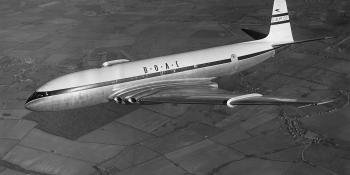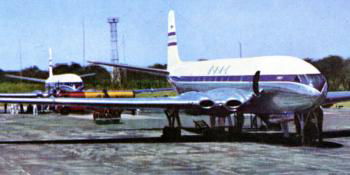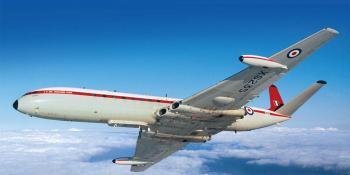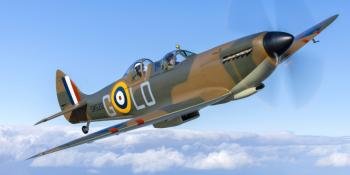“We have got the taps right open”. So read one of the radio messages passed from British Overseas Airways Corporation DH Comet 4 G-APDB to a sister aircraft as they made the first commercial jet flight across the Atlantic, between New York and London, 60 years ago — and injected new hope into the troubled Comet story
Imagine a new airliner, one seen as vital to a whole country’s future civil aviation prospects, departing for its inaugural scheduled service today.
For such an event to be conducted out of the media’s full glare is wholly unthinkable. Yet that’s exactly what happened when BOAC de Havilland Comet 4 G-APDB left New York’s Idlewild Airport on the early morning of 4 October 1958. Except for those already in the know, most people were unaware of the first scheduled commercial jet flight from New York to London until after it had happened.

There was no grand ceremony, nor even a celebratory photo of the crew and passengers. A few shots were taken of the Comet touching down at London Airport, but little else. ‘Lowkey’ barely covers it.
BOAC was in a mood to celebrate afterwards, though. Not only had ‘Delta Bravo’ made a piece of history, but sister aircraft G-APDC completed the reciprocal trip at the same time, and with rather more fanfare at the London end. It had set out first, but was second to land by virtue of the need to make a fuel stop en route. On that October day 60 years ago, BOAC and de Havilland appeared finally to have put the Comet disasters of 1953-54 behind them. And, above all, they had beaten the Americans.
It all happened pretty quickly.
G-APDB made its maiden flight from the DH factory airfield at Hatfield on 27 July 1958, in the hands of deputy chief test pilot Pat Fillingham, and was delivered to London Airport — as Heathrow was then more commonly known — on 12 September. With crew training over and a certificate of airworthiness obtained, an official hand-over ceremony was staged there on the last day of that month. Given that Pan American was soon to introduce the Boeing 707-120 on the North Atlantic route, time was very much of the essence.
To maximise impact, with two Comet 4s available it was decided to pre-position one of the machines to New York on what BOAC dubbed a ‘pre-inaugural proving’ flight and thereby mount a double first. This was ‘Delta Bravo’. At the delivery ceremony the carrier’s chairman, Sir Gerard d’Erlanger, said, “A certain amount of shakedown flying will have to be done with each of them, of course, before we use them in service.
Then we shall be ready to go… I do not wish to give a firm date for the introduction of the Comet 4 into service […] but I assure you that we shall put it into service the moment we are ready to do so… In two days’ time we shall start proving and training flights between London and New York.”
The ‘pre-inaugural’ trans-Atlantic trip was to have carried journalists from the specialist technical and aviation media. Suddenly, this plan was changed. With the need to obtain maximum coverage in mind, it was decided instead to take representatives of the national press in the 22 available seats. Space was at a premium as extra crew members and ground staff, together with the odd VIP, needed to travel too.
G-APDB duly took off from Heathrow at 12.30hrs on Thursday 2 October. In command was Capt Tom Stoney, manager of BOAC’s Comet Flight. Among those also on board were the respective BOAC and de Havilland managing directors, Basil Smallpeice and Aubrey Burke. They were bound for Idlewild via a stop at Gander, Newfoundland, which would be commonplace on eastbound flights. Strong headwinds kept the speed down, but the Comet alighted in New York 10 hours 32 minutes after leaving London, its flight time for the 3,500 or so miles being eight hours 53 minutes.
This was all very impressive, but still no announcement was forthcoming about the start of scheduled services. The reason was bureaucratic. Although Comet 4 noise trials in New York had been completed back in August, the Port of New York Authority — responsible for the city’s airports — had yet to give clearance.
In public, Smallpeice was hopeful, but careful not to express undue confidence.
“Basil Smallpeice made a great deal of how much experience had been accrued in preparation. BOAC still had ‘120 pilots experienced in operating pure jets in scheduled public service’ “
The next day, he could go further.
The authority signed off both Comet and 707 operations, albeit under certain conditions.
Jet aircraft, it decided, would only be able to take off from Idlewild’s runways 25 and 22, “which face south-west and take aircraft over Jamaica Bay during initial climb”. If this were not possible, they could use runways 13 right, 31 left and 7, “so long as turns are made as soon as possible away from communities and the minimum altitude over any community is 1,200ft”. Between 22.00 and 07.00hrs, only runways 25 and 22 could be used.
Pan Am objected, saying the rules unduly favoured the Comet’s performance. At a press conference held on the evening of 3 October at BOAC’s new offices on Fifth Avenue, Smallpeice made clear his irritation with the American carrier.
“Any suggestions”, he said, “that conditions are not reasonable are not only without foundation but also show considerable lack of good sportsmanship.”
The MD made a great deal of how much experience had been accrued in preparation.
Despite the years that had passed since the Comet 1’s premature retirement, BOAC still had “120 pilots experienced in operating pure jets in scheduled public service”. During training and development sorties with Comet 2Es, its crews had made 50 Atlantic crossings. The corporation and de Havilland then carried out five more in Comet 4s. Eleven BOAC line pilots had completed 16 trans-Atlantic trips by jet.


More generally, he pointed out, Royal Canadian Air Force Comets had routinely flown across ‘the Pond’, and the type had many other long-distance flights to its name, not least in RAF hands. No wonder Smallpeice declared, “we feel in BOAC that we have every confidence in mounting a service.”
He was understandably delighted.
Clearance meant BOAC could announce that scheduled Comet operations would begin the next day with a double inaugural flight: one eastbound, one westbound.
According to a piece in Flight, “lastminute efforts were made by BOAC to advise the many people who had long-standing bookings for the first Comet service”. One American businessman, it was reported, had signed up as early as 1952. It was, of course, necessary to take fare-paying passengers in order to claim that commercial services had started.
The BOAC publicity machine went into a higher gear. The Duxford Aviation Society, which preserves ‘Delta Bravo’ as part of its British Airliner Collection, holds a range of related memorabilia and period accounts. Among them are copies of internal company publication BOAC Review, the November 1958 edition of which reported, “Comet services began some weeks sooner than the carefully arranged [promotional] programme had allowed for”. This was to take in print advertisements, stickers for BOAC offices and agents, window displays, posters, postcards and more.
In a great rush, given the compressed timescale, the airline’s chief press and publicity officer Freddie Gillman had spent the previous Wednesday contacting newspapers and news agencies, asking, “if they could have a correspondent ready at London Airport by ten o’clock the next morning, complete with passport, visa and health certificate”. The possibility that commercial flights might be able to begin on Saturday was much in mind. Thus, “the Sunday newspapers were a ‘must’.”
Saturday 4 October dawned, and with it nothing less than a new era for BOAC. Representatives of the airline accompanied journalists covering the departure from London of Comet G-APDC, Capt Roy Millichap at the helm. It lifted off at 09.55hrs local time. Sir Gerard d’Erlanger joined 31 passengers, of whom 11 were fare-paying, and 15 crew or supernumerary crew members. The rest included BBC air correspondent Reginald Turnill.
At this time, G-APDB was still being prepared at Idlewild for its part in the day’s events. Stoney was again to captain the machine, joined on the flight deck by co-pilot Capt Minns.
It would have 28 passengers — five of them fare-paying — and 16 staff members on board. Smallpeice was among them, while representing the BBC on this flight was its Washington bureau correspondent, Christopher Serpell. They left at around daybreak in New York, 07.01hrs local, equating to 12.01hrs British Summer Time.


Just over two-and-a-half hours later, at around 14.35hrs BST, messages were passed between the two Comets as they traversed the ocean in opposite directions.
“One message passed between the Comets said, ‘Delta Charlie from Delta Bravo. The winds which are not in your favour are in fact very favourable to us. We hope to do a very fast flight. We have got the taps right open’ “
“Jet Speedbird Delta Charlie to Delta Bravo. This is Captain Millichap. I have a message for Captain Stoney from the chairman of BOAC, Sir Gerard d’Erlanger.
The message reads, ‘All of us aboard Comet Delta Charlie send to all aboard Comet Delta Bravo greetings on this great occasion.’
“Delta Charlie from Delta Bravo.
Thank you very much for your message. We have a message for the chairman from the managing director. Here is the managing director. ‘Thank you very much for your message. All aboard Delta Bravo send greetings and good wishes to all on board Delta Charlie. We have our glasses charged ready to toast you as we pass. We hope you are having as good a flight as we are having.’
“Delta Bravo from Delta Charlie.
Thank you. We are having a really good flight although the winds are not in our favour. Thank you for your message.
“Delta Charlie from Delta Bravo.
The winds which are not in your favour are in fact very favourable to us. We hope to do a very fast flight.
We have got the taps right open.
“Delta Bravo from Delta Charlie.
All the passengers are enjoying the flight very much indeed. We understand you are making really good time.”
They were. As G-APDC was making its pre-planned, one-hour 10-minute stop at Gander, G-APDB was still cruising at 37,000ft and an air speed of almost 500mph. Those on board were offered a special menu: to start, consommé Yvette and cream of mushroom soup, followed by small lobsters in mayonnaise; then, tournedos Rossini with cold Scottish pheasant, Pommes à la Mascotte, buttered haricot beans and a variegated salad; for dessert, Poire belle Hélène with double cream; various cheeses, a basket of fresh fruit, coffee and, finally, a selection of treats. There was a full range of alcoholic and soft drinks, together with a choice of Virginian or American cigarettes.
VIEW FROM THE CABIN
When Comet G-APDB first flew the Atlantic, on 2 October’s ‘pre-inaugural’ trip, the specialist press was not on board. However, The Aeroplane received impressions from a reporter who was afforded the privilege.
“Occasional announcements break the calm that pervades the passenger cabin — we are now passing over Weather Ship ‘Juliet’, which informs us that she has sighted our vapour trails through a break in the clouds; we are now climbing from 32,000ft to 39,000ft, having passed a Europe-bound B-47 which has been cleared down from that altitude.
“The Comet begins its let-down to Gander prior to crossing the Newfoundland coast and a passenger begins to realise the advantages of flying closer to the sun when he finds himself descending — smoothly, almost unobtrusively — into the murkier climate of a workaday world, to make a smooth circuit and a gentle landing. It seems such a short time since London was left behind, and it is not until one is informed by Capt T. B. Stoney, manager of BOAC’s Comet Flight, that the 2,360 statute miles from London have been covered in 5hr 28min that one realises how divorced from the world one has been…
“The flight on from Gander repeats all of the enjoyments experienced hitherto, with the exception that on this leg the adverse wind component goes up to 145mph, and the cloud is now more broken. Even so, it seems only too soon that the stewardess is announcing that we are beginning our let-down for Idlewild, although our time for the 1,145 miles from Gander has been more than three hours. After a wide sweep over the sea and across Jamaica Bay, the Comet touches down gently — 3 hours 25 minutes after take-off, giving an average ground speed of 339mph.
“Flying as a passenger in the Comet 4 is not just another unique experience — it is a new way of life for the air traveller, enabling him to view the world with different eyes. This is an impression with which one is left.”

After six hours 12 minutes, ‘Delta Bravo’ landed in London at 18.13hrs local. It was a new record time for a non-stop New York-London flight, achieved at an average speed of 565mph, aided by a 92mph tailwind.
‘Delta Charlie’, meanwhile, reached Idlewild at 15.18hrs local (20.18hrs BST). Its trip had taken 10 hours 20 minutes, including one hour 10 minutes on the ground at Gander.
BOAC had done it. According to BOAC Review, a British journalist in Russia overheard a leading official of the Intourist state travel agency saying, “he was glad Britain had beaten the Americans into second place with the jets”, adding, “Of course, our Tupolevs could run the service any day a great deal faster…”
British media coverage was, naturally, considerable. G-APDB’s captain, Stoney, even appeared as the guest TRANS-ATLANTIC COMET celebrity on BBC show What’s My Line? “The studio audience recognised him immediately and applauded heartily”, the BOAC publication crowed, “while the blindfolded panel guessed who he was without hesitation.”
“A leading official of Russia’s Intourist state travel agency said ‘he was glad Britain had beaten America into second place with the jets’, adding, ‘Of course, our Tupolevs could run the service any day a great deal faster’ “
Prime Minister Harold Macmillan sent a message of congratulation to Geoffrey de Havilland. “The resurgence of a Comet airliner”, ‘SuperMac’ wrote, “is a fitting reward for faith in the future of this fine product, and the whole nation takes pride in the fact that a British aircraft has led the world into a new turbojet age”. His was a view shared by many.
But now there began the more serious business of translating this promise into commercial success.
While all the excitement had been going on, another Comet 4, G-APDE, had been delivered to BOAC on 1 October. With these three aircraft, all in 48-seat configuration, the corporation gradually built up to a daily trans- Atlantic schedule by mid-November.
It had stolen a march: 22 days after the Comet’s record-breaking feat, Pan Am launched the 707-120, which it dubbed its ‘Jet Clipper’, on its route linking New York and Paris via London, with a regular fuel stop at Keflavík, Iceland.
Both carriers knew their initial jet equipment was less than ideal for the North Atlantic, given the inability of either Comet 4 or 707-120 to always go non-stop. The British aircraft’s glory, indeed, would be fairly shortlived.
But, basking in the glow of its world-beating performance 60 years ago, that hardly mattered to de Havilland or to BOAC.
ACKNOWLEDGEMENTS: With thanks to Chrissie Eaves- Walton and Geoff Russell of the Duxford Aviation Society. For more information on the DAS and the rest of its British Airliner Collection, visit www.das.org.uk
WHAT ‘DELTA BRAVO’ DID NEXT

The first commercial trans-Atlantic jet flight was not Comet 4 G-APDB’s only notable trip of October 1958.
On the 28th, again with Capt Stoney flying but now with a specially equipped interior, it conveyed the Duke of Edinburgh from London to Ottawa and went on to transport him throughout his tour of Canada.
Then, on 13 November, the aircraft performed the first New York-London flight of BOAC’s new daily trans-Atlantic schedule.
In mid-1960, however, the corporation retired the Comets from the route. Their replacement, rather ironically, was the Boeing 707, in Rolls-Royce Conway-engined 707-420 form. The de Havilland aircraft were redeployed on the sort of services for which they had originally been designed, to Africa, the Far East, Australia, South America and the West Indies. Seating capacity was eventually raised to 81.
BOAC phased out the Comet 4s in 1965.
G-APDB went to Malaysian Airways, subsequently Malaysia-Singapore Airlines, as 9M-AOB. However, it reverted to its old registration in September 1969 following its purchase by legendary independent British carrier Dan-Air. Inclusive tour flights were now the order of the day for ‘Delta Bravo’, which was based at Gatwick and fitted with 106 seats.
The Comet’s final commercial flight, conducted on behalf of tour operator Clarksons Holidays, was from Alicante to Teesside on 12 November 1973. It was then retired to Dan-Air’s engineering base at Lasham, Hampshire. In view of its importance, the airline decided to donate the aeroplane to the East Anglian Aviation Society for preservation at Duxford, where it had established a presence alongside the Imperial War Museum. G-APDB made its last flight to the Cambridgeshire airfield on 12 February 1974. Upon establishment of the Duxford Aviation Society in 1975, the Comet was transferred to its collection and became the DAS’s first airliner exhibit.
Displayed for many years in Dan-Air colours, prior to the opening of Duxford’s AirSpace building during 2007 G-APDB was restored to its original BOAC livery. It has been housed in AirSpace ever since.
Each DAS aircraft has its own designated custodian; the Comet’s is Geoff Russell, who takes great pride in the aircraft’s upkeep and the numerous historical exhibits contained inside the cabin, including many items relating to the 1958 flight. Hopefully, Geoff reports, it will at some point prove possible to refit seating of the type that was installed when ‘Delta Bravo’ served with BOAC, though this is a long-term project. But even without this period detail, G-APDB is the finest example of a Comet 4 still extant in the UK, and undoubtedly the most historic, too.









